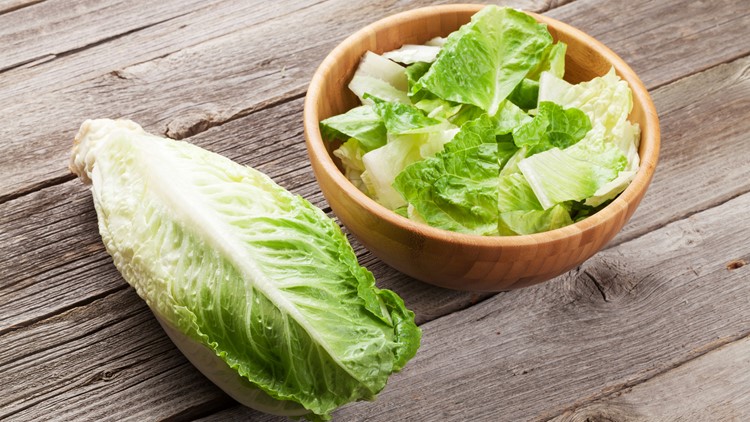PHOENIX — Chopped romaine lettuce from the Yuma, Az. growing region is suspected in an E. coli outbreak that has hospitalized 31 people, according to a report Wednesday from the U.S. Centers for Disease Control and Prevention.
The Centers for Disease Control and Prevention, the lead public health agency investigating the outbreak, on Wednesday updated the number of illnesses to 53 from 35.
At least 16 states have reported ill people. In its Wednesday update, the CDC said new cases had been reported in five additional states: Alaska, Arizona, California, Louisiana, and Montana.
The agency said that at least 31 people were hospitalized from eating the tainted greens. Five people have suffered kidney failure. No deaths have been reported.
It did not identify any growers, suppliers, distributors or brands associated with the outbreak.
"Information collected to date indicates that chopped romaine lettuce from the Yuma, Arizona, growing region could be contaminated with E. coli," the CDC said in the update. "At this time, no common grower, supplier, distributor, or brand has been identified."
People began getting sick March 13 and illnesses continued being reported through April 6. Victims range in age from 10 to 85, the CDC said.
Illnesses that occurred after March 29 might not yet be reported because of the gap when someone gets sick and when it is reported to public health agencies. The CDC said reporting can take up to three weeks.
What is E. coli?
E. coli is the shortened name of a bacteria called Escherichia coli found in the environment, foods, and intestines of people and animals, according to the CDC. It can cause diarrhea, urinary tract infections, pneumonia and kidney failure. Some strains of E. coli aren't dangerous, but others can be fatal.
It takes an average of three to four days to get sick after eating food infected with E. coli, but it can take up to eight days.
Most people experience diarrhea, severe stomach cramps and vomiting and recover within one week. Anyone taken ill should contact a doctor if diarrhea "lasts more than 3 days or is accompanied by high fever, blood in the stool, or so much vomiting that you cannot keep liquids down and you pass very little urine," according to the CDC.
Children younger than 5, older adults and people with weakened immune systems are more likely to develop hemolytic uremic syndrome.
"Symptoms of HUS can include fever, abdominal pain, pale skin tone, fatigue and irritability, small, unexplained bruises or bleeding from the nose and mouth, and decreased urination," according to the CDC. People experiencing such symptoms should seek emergency medical care.
Past outbreak spurred new safety standards
Ten years ago, no uniform standards existed for leafy greens coming out of the field. It was up to the industry to police itself.
An E. coli outbreak in 2006 changed the leafy-green industry's approach to food safety. Three people died and 205 were sickened in 26 states.
An investigation by the Food and Drug Administration ultimately traced the outbreak to Dole brand baby spinach farmed in California. But before the source could be confirmed, and as more victims went to emergency rooms across the country, the FDA sent a message: Don't eat spinach.
The FDA didn't specify a brand or a region or a date. It simply warned consumers that spinach wasn't safe. Overnight, grocery stores purged their shelves and restaurants altered their menus. And the spinach industry lost an entire crop.
Produce growers, who had long resisted government oversight and the need for industry-wide safety standards, found themselves facing calls for state and federal regulation and demands for public accountability.
Their response was a voluntary program called the Leafy Green Marketing Agreement, which required members to adopt rigorous food-safety standards, inspections and audits.
The program, developed with the help of university scientists, agricultural specialists, food-safety industry experts and government oversight agencies, created protocols for every aspect of the process. It covered pesticides, irrigation, field workers, equipment, storage and transportation.
The agreements were supported by produce buyers and retailers who aimed to ensure customers that their commodities were safe. Grocery chains signed agreements to buy only from LGMA-certified growers.
Companies that grow and ship leafy greens were forced to join or they quickly found themselves without buyers for their produce.
The professional agreements, audits and safety procedures haven't fully eliminated E. coli and other pathogens from sickening the public.
In 2012, Canadian health officials said they traced tainted lettuce to an LGMA member in Riverside County, California.
A 2013 outbreak that sickened KFC, Taco Bell, Burger King and Pizza Hut customers in Canada was traced to a California LGMA member farm.
Outbreak
Here is a breakdown of people infected with the strain of E. coli O157:H7, which has been traced to tainted romaine lettuce in Yuma:
- Arizona, 3
- Alaska, 1
- California, 1
- Connecticut, 2
- Idaho, 10
- Illinois, 1
- Louisiana, 1
- Michigan, 2
- Missouri, 1
- Montana, 6
- New Jersey, 7
- New York, 2
- Ohio, 2
- Pennsylvania, 12
- Virginia, 1
- Washington, 1
Source: Centers for Disease Control and Prevention
Contributing: TEGNA Staff



